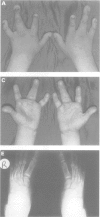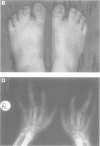Abstract
Syndactyly type I is an autosomal dominant condition with complete or partial webbing between the third and fourth fingers or the second and third toes or both. We report here a previously undescribed phenotype of severe mesoaxial syndactyly and synostosis in patients born to affected parents. The characteristic features of these severe cases are (1) complete syndactyly and synostosis of the third and fourth fingers; (2) severe bone reduction in the proximal phalanges of the same fingers; (3) hypoplasia of the thumbs and halluces; (4) aplasia/hypoplasia of the middle phalanges of the second and fifth fingers; and (5) complete or partial soft tissue syndactyly of the toes. We report on three offspring with this phenotype from two different branches of a syndactyly type I family, suggesting that they may be homozygous for this condition. SSCP and linkage analysis indicated that neither HOXD13 nor other relevant genes in the chromosome 2q31 region was responsible for this phenotype.
Full text
PDF






Images in this article
Selected References
These references are in PubMed. This may not be the complete list of references from this article.
- Akarsu A. N., Akhan O., Sayli B. S., Sayli U., Baskaya G., Sarfarazi M. A large Turkish kindred with syndactyly type II (synpolydactyly). 2. Homozygous phenotype? J Med Genet. 1995 Jun;32(6):435–441. doi: 10.1136/jmg.32.6.435. [DOI] [PMC free article] [PubMed] [Google Scholar]
- Akarsu A. N., Stoilov I., Yilmaz E., Sayli B. S., Sarfarazi M. Genomic structure of HOXD13 gene: a nine polyalanine duplication causes synpolydactyly in two unrelated families. Hum Mol Genet. 1996 Jul;5(7):945–952. doi: 10.1093/hmg/5.7.945. [DOI] [PubMed] [Google Scholar]
- Muragaki Y., Mundlos S., Upton J., Olsen B. R. Altered growth and branching patterns in synpolydactyly caused by mutations in HOXD13. Science. 1996 Apr 26;272(5261):548–551. doi: 10.1126/science.272.5261.548. [DOI] [PubMed] [Google Scholar]
- Sarfarazi M., Akarsu A. N., Sayli B. S. Localization of the syndactyly type II (synpolydactyly) locus to 2q31 region and identification of tight linkage to HOXD8 intragenic marker. Hum Mol Genet. 1995 Aug;4(8):1453–1458. doi: 10.1093/hmg/4.8.1453. [DOI] [PubMed] [Google Scholar]
- Sayli B. S., Akarsu A. N., Sayli U., Akhan O., Ceylaner S., Sarfarazi M. A large Turkish kindred with syndactyly type II (synpolydactyly). 1. Field investigation, clinical and pedigree data. J Med Genet. 1995 Jun;32(6):421–434. doi: 10.1136/jmg.32.6.421. [DOI] [PMC free article] [PubMed] [Google Scholar]
- Winter R. M., Tickle C. Syndactylies and polydactylies: embryological overview and suggested classification. Eur J Hum Genet. 1993;1(1):96–104. doi: 10.1159/000472392. [DOI] [PubMed] [Google Scholar]







